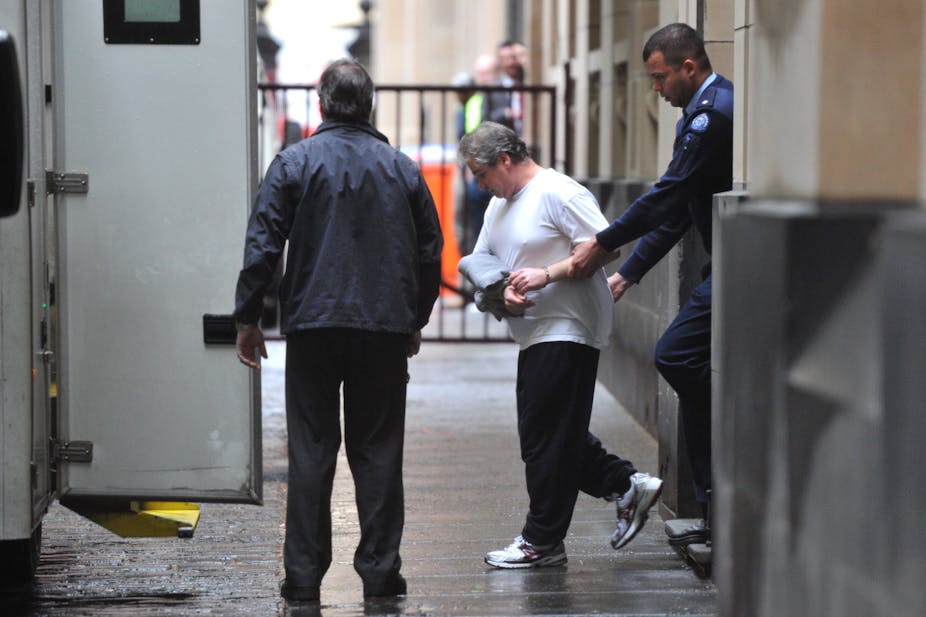Helen Garner isn’t usually thought of as a crime writer, but some of her best-known prose has been on law-breaking. She won the prestigious Walkley Award for her 1993 Time Magazine article on the murder of toddler Daniel Valerio. Then there were her bestsellers The First Stone (1995) and Joe Cinque’s Consolation (2004).
Those last two books are particularly striking in their intertwining of crime and sexual politics.
Both featured male key protagonists who were – at least in Garner’s eyes – victimised by vengeful young women. The First Stone was widely criticised for trivialising the issue of sexual harassment. The man at the centre of that text was a university college master who was accused of sexually harassing five female students, two of whom reported his behaviour to the police. Garner attributed their allegations to a feminist-fuelled misandry.
Thus, it was with some interest that I – an Australian literature scholar who has previously written on Garner’s work – began reading Garner’s recently-published This House of Grief (2014).
Once again, the author becomes engrossed in a criminal trial, and this time it’s the trial of Robert Farquharson. In September 2005, while driving down the Princes Highway in rural Victoria, Farquharson’s car veered off the road and into a dam.
Farquharson swam to safety, but his three sons, also travelling in the vehicle, drowned. In the ensuing investigation, it was revealed Farquharson had allegedly threatened to kill the children to punish his ex-wife, Cindy, for ending their marriage. Farquharson denied making this threat.
He attributed the crash, and his children’s subsequent deaths, to “cough syncope” (“a very brief loss of consciousness that follows an episode of intense coughing”, as Garner puts it). In October 2010, Farquharson was sentenced to life imprisonment with a non-parole period of 33 years.
So, I asked myself as I snapped up my copy of This House of Grief at the local Readings outlet, has anything changed since 2004 – or, for that matter, 1995? Is Garner going to spin yet another noir-ish narrative in which a flawed but basically decent bloke is oppressed by a heartless vixen? Or will something altogether different happen in these pages?

And the news is good – to some extent. There are no femme fatales to throw stones at here, nor is there any attempt to paint Farquharson as a good guy who cracked under the weight of a world that is apparently unkind to the male of species. Garner at least seems to achieve the kind of balanced, thorough and objective reportage that she promised (but never delivered) all those years ago with The First Stone.
The court case – with its legalese, endless parade of “experts” and heightened emotions – is described in painstaking detail. And there’s the overwhelming air of sadness. As Garner so eloquently puts it: “The children’s fate is our legitimate concern. They are ours to mourn”. One is instantly reminded of her piece on Daniel Valerio.
But crime doesn’t take place in a vacuum, and the Farquharson case is no exception. This should be obvious, but it isn’t – to Garner. Let me be specific: This House of Grief largely fails to address the broader issues of gender inequality and male violence.
There has been significant media coverage given to the issue of male violence since the 2012 death of Jill Meagher. Meagher was raped and murdered. Not all male violence takes the form of brutalising women. In an article published earlier this year in The Age, Deborah Kirkwood (a researcher at the Domestic Violence Resource Centre Victoria) is quoted as saying that:
fathers who killed their children ‘feel entitled to take their lives because they’re his possessions … It’s about making the mother suffer.
Kirkwood’s research has focused on Ramazan Acar and Arthur Freeman. Both men were convicted of killing their children in acts of revenge against their former partners.
My point is not that Farquharson really did intend to kill his children. The only person in the world who can ever know these intentions is Farquharson himself. My point is rather that those children’s deaths cannot be entirely separated from crimes such as those cited above, nor from the broader field of sexual politics.
When we read that Farquharson allegedly threatened to “pay [Cindy] back big-time”, how can one not discuss questions of male power and entitlement? What of the fact that the children died on Father’s Day, of all days? In This House of Grief, even that anodyne term “gender” barely rates a mention.
Ultimately, crime writing is political. Crime writers help frame the ways in which particular crimes are discussed, understood, remembered. This is particularly the case when the author is as high-profile as Helen Garner.
In This House of Grief, Garner’s eye for detail is unsurpassable. The melancholy she evokes is haunting. But Garner’s failure to pursue the hard questions about male violence that are raised by the Farquharson case is a mystery – and a disappointment.

